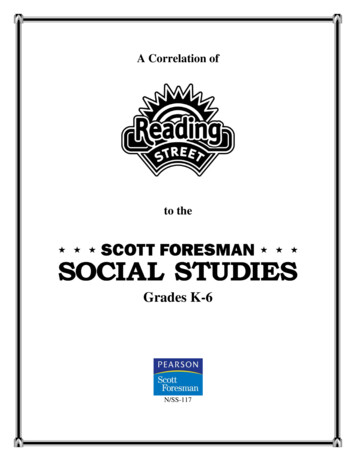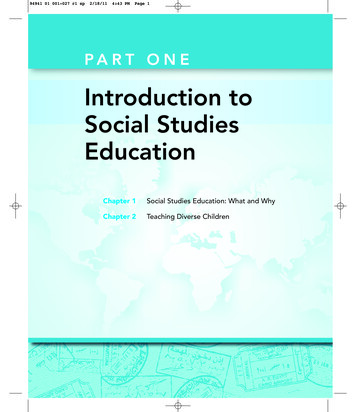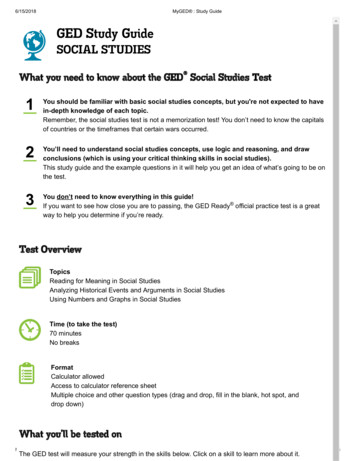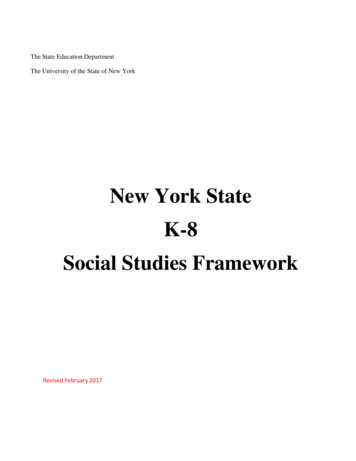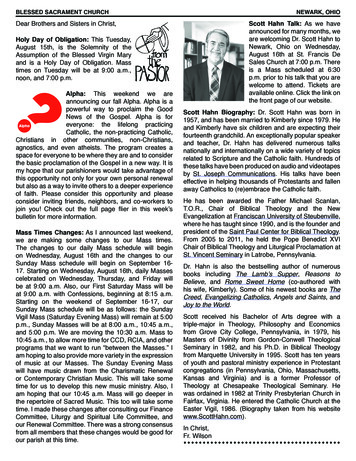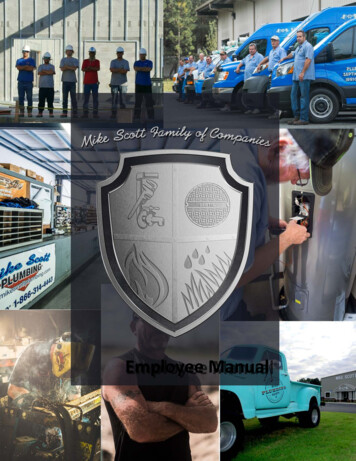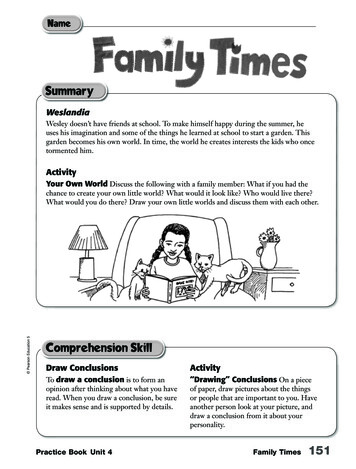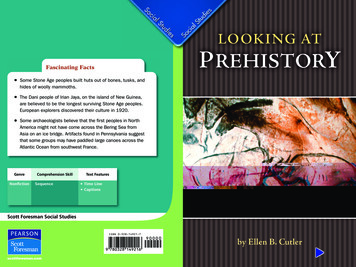
Transcription
LOOKING ATP REHISTORYFascinating Facts Some Stone Age peoples built huts out of bones, tusks, andhides of woolly mammoths. The Dani people of Irian Jaya, on the island of New Guinea,are believed to be the longest surviving Stone Age peoples.European explorers discovered their culture in 1920. Some archaeologists believe that the first peoples in NorthAmerica might not have come across the Bering Sea fromAsia on an ice bridge. Artifacts found in Pennsylvania suggestthat some groups may have paddled large canoes across theAtlantic Ocean from southwest France.GenreNonfictionComprehension SkillSequenceText Features Time Line CaptionsScott Foresman Social StudiesISBN 0-328-14921-7ì (sk m) bejcbg -Ä-U-Ä-Uby Ellen B. Cutler
One way to learn about how people once lived is through the studyof the tools, art, and other objects they left behind. In this bookyou will read about early people and the ways we study their lives.VocabularyLOOKING ATWrite to It!Suppose that you are an archaeologist. What do you thinkwould be the most important kind of artifact that you couldfind? Write one or two paragraphs describing your artifactand why you think it would be important.P REHISTORYcultureprehistoryWrite your paragraphs on a separate sheet of ologistartifactcarbon datingIllustrationby Ellen B. Cutler4 Randal Birkey8 Higgins BondPhotographsEvery effort has been made to secure permission and provide appropriate credit for photographic material. The publisher deeplyregrets any omission and pledges to correct errors called to its attention in subsequent editions.Unless otherwise acknowledged, all photographs are the property of Scott Foresman, a division of Pearson Education.ISBN: 0-328-14921-7Photo locators denoted as follows: Top (T), Center (C), Bottom (B), Left (L), Right (R) Background (Bkgd)Copyright Pearson Education, Inc.All Rights Reserved. Printed in the United States of America. This publication is protectedby Copyright, and permission should be obtained from the publisher prior to any prohibitedreproduction, storage in a retrieval system, or transmission in any form by any means,electronic, mechanical, photocopying, recording, or likewise. For information regardingpermission(s), write to: Permissions Department, Scott Foresman, 1900 East Lake Avenue,Glenview, Illinois 60025.Opener: Gaillarde Raphael/Ministere de la Culture/Draclyo/Gamma Presse, Inc.2 Erich Lessing/Art Resource, NY3 Grant Heilman Photography6 Musée des AntiquitésEditorialSt GermainOffices:en Laye /Glenview,Dagli Orti/TheArt ArchiveIllinois Parsippany, New Jersey New York, New York7 Victoria & Albert Museum, London/Art Resource, NY10 Kenneth GarrettSales Offices: Needham, Massachusetts Duluth, Georgia Glenview, Illinois11 Erich Lessing/Art Resource,NYTexas Sacramento, California Mesa, ArizonaCoppell,12 Gaillarde Raphael/Ministere de la Culture/Draclyo/Gamma Presse, Inc.14 Eric Vandeville/Gamma Presse, Inc.1 2 3 4 5 6 7 8 9 10 V0G1 14 13 12 11 10 09 08 07 06 05
Prehistory and CultureIn anthropology the word culture refers to the shared experiences ofa group of people. These shared experiences include both beliefs andlearned knowledge.Beliefs are the ideas and attitudes that influence lives. Socialattitudes are beliefs. Social beliefs may cause people to treat somemembers of a family or a village differently from others.Learned knowledge is the set of skills that people need to live.Prehistoric people knew how to use fire, make tools, and care for sickor injured individuals. As learned knowledge is handed down from onegeneration to the next, it is also improved.Finding, growing, andpreparing food are allforms of knowledge.The story of the past is told through words and objects.Talking About the PastHistory is the story of things that took place in the past. It tellsabout the rise and fall of kingdoms, discoveries in science, artisticachievements, and religious beliefs. History is made by people who arefamous and by people whose names are no longer known. History is thewritten record of human culture. The documents of history include codesof law, newspaper accounts, personal journals, and business records.Prehistory is the period of human culture that came before theinvention of writing. History is about five thousand years old—butprehistory is much, much older.23
The Beginning and End of PrehistorySome prehistoric cities had stone buildings and large temples.4Anthropologists, or people who study anthropology,agree that human culture is extremely old. They do notagree, however, on when prehistory began.Some anthropologists say prehistory started about2 million years ago when our ancestors began to usetools. Still others say that prehistory started about100,000 years ago when the first modern humanbeings appeared.In general, anthropologists agree that prehistoryended with the invention of written language. Writingwas invented, however, at different times in differentplaces. Writing was invented in Egypt and in what is nowIraq about five thousand years ago. Ancient China hada writing system about four thousand years ago. TheAztecs, who lived in Mexico seven hundred years ago,never developed a written language, but they did use asystem of simple pictures to keep records.5
Prehistory and The Age of StonePrehistory is divided into three ages: the Stone Age, the Bronze Age,and the Iron Age. Many scientists disagree as to when each of theseages ended and the next began. What they do agree on is that ourprehistory took place almost entirely in the Stone Age.Early Stone Age peoples were nomads who traveled from place toplace with the seasons. They collected fruits and nuts and huntedanimals. They made tools from things that were easily carried, such asstone, wood, bones, and shells. Late Stone Age cultures discoveredagriculture. People in these cultures raised cows, horses, goats, anddogs. They grew grains and other plants. At the end of the Stone Age,people settled in villages. Some of the villages grew into cities.A bronze axe is an example of an early tool.Stone points show that early peoples made tools.Metal technology marked the end of the Stone Age. At the end ofthe Stone Age, people learned to heat copper ore to get copper metal.In the Bronze Age they melted copper and tin together to create aharder metal called bronze.The Iron Age followed the Bronze Age. The Iron Age began about3,000 years ago. Iron is a stronger metal than bronze, but it is moredifficult to work with. Iron tools and weapons were stronger than bronzeitems and lasted longer.Moving from One Age to the NextKnowledge of metal technology often passed from one culture toanother. Some peoples were introduced to iron without ever havinglearned about bronze. Some Stone Age cultures survived so long thatthey jumped directly into the modern era when they came into contactwith European explorers.7
A Time Line of Prehistory3 million years ago100,00080,00060,00040,00020,00010,000presentOld Stone AgeThe break in the time line means that a part of the time line hasbeen left out. In this case the years between 3 million years agoand 100,000 years ago have been left out of the time line.New Stone AgeProgress During the Stone AgeUsing FireThe Stone Age lasted about 2.5 million years. During the Stone Age,humans spread from the African continent throughout Europe, Asia,and North and South America. They became skilled at making stonetools and also produced many kinds of art, including carved animalfigures, cave paintings, and decorated pottery.Perhaps the most important “tool” in prehistory was fire. At firstearly humans may have taken advantage of small fires caused bylightning. They later figured out how to control these fires and keepthem burning. Finally they learned how to start fires themselves.Our ancestors were warming themselves with fire about 450,000years ago.Fire kept people warm in cold weather. It protected them fromattacks by wild animals. Cooking made food taste better. Meat dried inthe smoke did not spoil. A crackling fire would have encouraged peopleto gather together for warmth, safety, and company. Small fires made itpossible to work at night and in dark caves.Fire was important to prehistoric cultures.9
Carved Objects and Personal OrnamentsThe oldest prehistoric works of art were small, portable carvings,such as animal and human figures. Personal ornaments made fromivory, shells, and animal teeth were also common. This made sensefor nomads, who were always on the move. Stone Age artists alsodecorated weapons and other tools.Did these works of art have a purpose or a special meaning? Couldivory beads, for instance, show that the wearer was an importantperson? Perhaps an animal figure served as a good-luck charm. Thereis no way to know for sure.This knife with a stoneblade and a wovenpouch were probablyused around the NewStone Age.In addition to paintings, prehistoric people madefine rock carvings.The Things They Left BehindEarly ToolsArchaeologists study prehistoric cultures through theartifacts they left behind. The oldest artifacts are madefrom stone.The first tools were axes, scrapers, and knives. Theywere made from large pieces of rock that had been brokento produce a sharp edge. After a while Stone Age peopleslearned to flake thin pieces from large rocks. These flakedtools had sharp edges and points. They could be attached tosticks or long bones to make arrows and spears for huntingor scythes for cutting grasses and grains.Stone Age peoples shaped tools from stone, bone, andantler. A variety of points, including spearheads, awls forpoking holes in skins, and sewing needles, were made frombone, antler, and ivory.10
Paintings and Wall DecorationsWhy did they paint in caves?Some prehistoric artists were painters who decorated caves andstone cliffs with patterns and pictures. These artists made red, yellow,and brown paints with minerals they dug from the ground. They madeblack paint from burned bones and wood.First they ground colors into powder. Then they mixed the colors withwater or animal fat. They dabbed this paint on stone with their fingersor with twigs, or used brushes made from animal hair. They also blewdry, powdered color onto the cave walls through hollow bones.The paintings show a variety of animals, such as wild cattle, horses,lions, deer, woolly mammoths, rhinoceros, and goats. Human figuresare rare, but the outlines or prints of human hands are common.Patterns of dots, lines, and spirals decorate some of the caves.The purpose and meaning of these paintings are a mystery. The caveswould not have been good homes. They are dark, damp, and hard to get to.Pictures are often high up on walls and very hard to see.Many people think that the pictures were painted to help the hunters.Prehistoric people hunted many kinds of animals. Other animals appear inthe paintings, such as the rhinoceros, but they were not usually hunted forfood. The cave paintings at Chauvet, France, show images of rhinocerosfighting with each other.Perhaps some animals in the paintings represented spirits that StoneAge peoples feared or worshipped. Perhaps the caves were used forreligious ceremonies.Some scholars share the idea that the cave paintings are records tohelp people remember important ideas and events. When looked at fromthis point of view, cave paintings are like written records.This cave painting in Chauvet,France, shows images of horsesand rhinoceros.13
Archaeologists at a dig work carefullywith the artifacts they find.At the dig, archaeologists make a map of the area.Then they divide it into small sections called units. Eachunit has to be searched slowly and carefully.While some dirt can be removed with shovels andmachines, most of it is cleared away with brushes andtiny tools. Workers are careful not to break or scratchprecious artifacts.Who Made It . . . and When?Archaeologists have to decide when an artifact was made. In orderto determine this, it is important to know exactly where an objectwas found.Doing the DigThe first step in studying artifacts is to collect them. The excavationsite where archaeologists find objects is called a dig. Each dig is set upso that archaeologists can record exactly where each object was found.The ground is made up of layers of dirt, stone, and other material.The first clue about the age of an artifact is the age of the layer ofearth where it was found.14How old is really old?Carbon dating is another way to determine how old an artifact is. Allliving things contain the element carbon. One kind of carbon is calledcarbon 14, or C14. As long as a plant or animal is alive, it has C14inside it. When it dies, the C14 starts to disappear. Scientists knowthat it takes about fifty thousand years for C14 to disappear from adead plant or animal. If the C14 is all gone, then the object is at leastfifty thousand years old. Carbon dating cannot be used on stone, but itcan be used on paint or animal blood that is stuck to the stone.If a cave painting, for instance, has black paint made from burntwood or bone, a scientist can measure the amount of C14 in the paint.This is how archaeologists decide how old a cave painting might be.15
One way to learn about how people once lived is through the studyGlossaryof the tools, art, and other objects they left behind. In this bookagriculture the practice of raising plants or animals for human useyou will read about early people and the ways we study their lives.anthropology the study of how people have developed and live incultural groupsVocabularyarchaeologist a scientist whouncovers evidence, or proof, fromculturethe pastprehistoryartifact an object made by peoplelong agoWrite to It!Suppose that you are an archaeologist. What do you thinkwould be the most important kind of artifact that you couldfind? Write one or two paragraphs describing your artifactand why you think it would be important.Write your paragraphs on a separate sheet of paper.anthropologycarbon dating a method of estimatingthe age of an animal or a plantafter it has diednomadculture the way in which individualsand groups react with theiragricultureenvironment, including their technology, customs, beliefs, and arttechnologynomad a person who travels from place to place without aarchaeologistpermanent homeartifactprehistory the long period of timebefore people developed systemsof writing and written languagecarbon datingtechnology the way in which humans produce the items they useIllustration4 Randal Birkey8 Higgins BondPhotographsEvery effort has been made to secure permission and provide appropriate credit for photographic material. The publisher deeplyregrets any omission and pledges to correct errors called to its attention in subsequent editions.Unless otherwise acknowledged, all photographs are the property of Scott Foresman, a division of Pearson Education.ISBN: 0-328-14921-7Photo locators denoted as follows: Top (T), Center (C), Bottom (B), Left (L), Right (R) Background (Bkgd)Copyright Pearson Education, Inc.All Rights Reserved. Printed in the United States of America. This publication is protectedby Copyright, and permission should be obtained from the publisher prior to any prohibitedreproduction, storage in a retrieval system, or transmission in any form by any means,electronic, mechanical, photocopying, recording, or likewise. For information regardingpermission(s), write to: Permissions Department, Scott Foresman, 1900 East Lake Avenue,Glenview, Illinois 60025.Opener: Gaillarde Raphael/Ministere de la Culture/Draclyo/Gamma Presse, Inc.2 Erich Lessing/Art Resource, NY3 Grant Heilman Photography6 Musée des Antiquités St Germain en Laye / Dagli Orti/The Art Archive7 Victoria & Albert Museum, London/Art Resource, NY10 Kenneth Garrett11 Erich Lessing/Art Resource, NY12 Gaillarde Raphael/Ministere de la Culture/Draclyo/Gamma Presse, Inc.14 Eric Vandeville/Gamma Presse, Inc.1 2 3 4 5 6 7 8 9 10 V0G1 14 13 12 11 10 09 08 07 06 0516
Beliefs are the ideas and attitudes that influence lives. Social attitudes are beliefs. Social beliefs may cause people to treat some members of a family or a village differently from others. Learned knowledge is the set of skills that people need to live. Prehistoric people knew how
